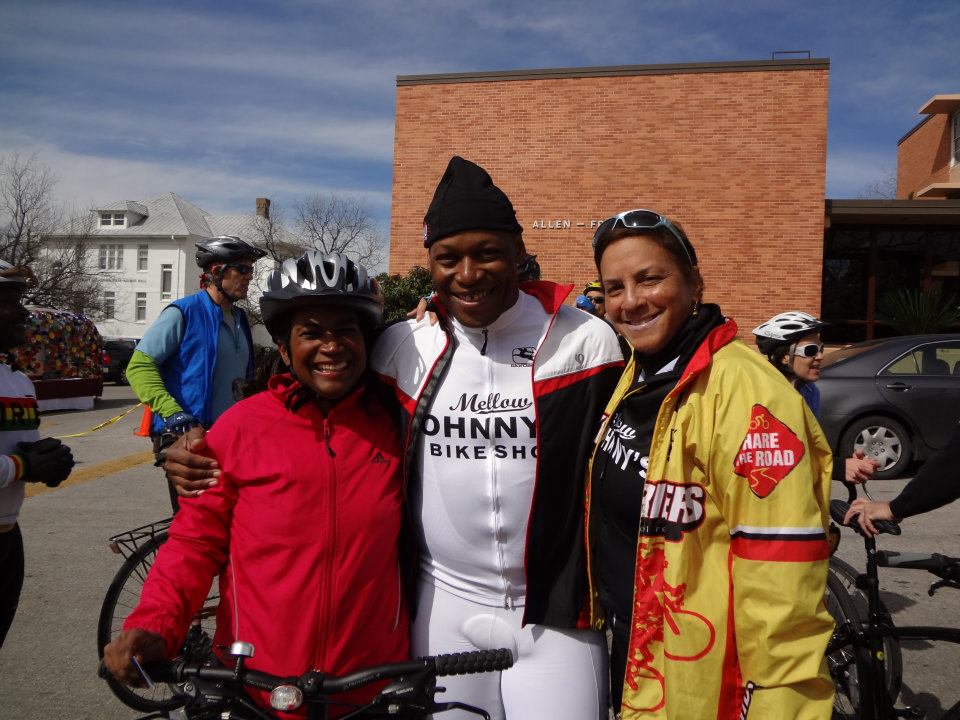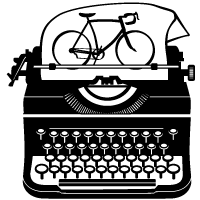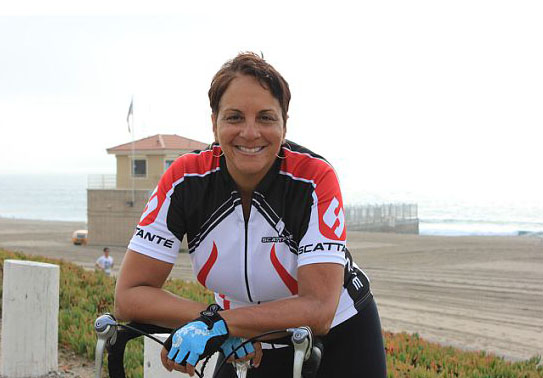Yolanda Davis-Overstreet is the Director of the upcoming documentary RIDE: In Living Color. The film looks at African American cyclists through history from Major Taylor’s amazing achievements in sport to people using bikes to change their lives in present day. Most of the filming is complete and the RIDE team is currently raising money through an IndieGoGo campaign to help fund post-production work. I spoke to Yolanda about the film and its production, her background in cycling, media coverage of African American cyclists, barriers to entry in cycling for people of color, and more.
What is your film about and what are you hoping to accomplish with it?
Our mission is to capture the amazing true life story of African American cyclists from the 1800s to today. We want to show how cycling has impacted these lives in phenomenal and diverse ways. Looking at our involvement as African Americans in cycling as far back as the 1800s, you have Major Taylor. He is, of course, the model that a lot of African American cyclists really aspire to in road biking. But I think anyone can be inspired by what he had to go through under the conditions he had to live in 1899 to become a world cycling champion. He was able to see life as it was and be really thankful and humble enough to take in all the adversity and get out there and still be a champion. Basically, we want to tap into what African Americans were doing at that time, to try and reveal why we aren’t, in many respects, as involved in cycling today.
If you look at history, when you’re banned from riding in organizations and riding in particular groups, then you’re told “this is not where you belong.” When we see a lot of African Americans aren’t riding to this day, I think it was something from generations ago because bicycling wasn’t something we could do. So then we fast forward from looking at our past and move into today’s inspirational stories.
We interviewed two men that have diabetes and are cyclists. Art Jones rides with the Major Taylor club down in San Diego. He was a BMX rider as a kid. At 19 he went blind from diabetes. But his body was familiar with riding a bike, it still was in him. Today he’s 42 and he just completed the California Triple Crown riding three double centuries in a year with his tandem partner Don Count. Someone who could see would even have a challenge completing a Triple Crown. African American doesn’t even really have anything to do with it. He’s the first blind person to complete a Triple Crown who just happens to be African American.
The film ranges from your everyday person who’s gotten on a bike and made their life phenomenal to champion athletes. We look at some African American Olympians to see what pushed them, motivated them, especially because there aren’t a lot of African Americans in this sport. Nelson Vails was the first African American to win the silver medal in 1984. We also interviewed a more current Olympian, Giddeon Massie. He’s a two time Olympian. It’s really interesting to hear what they have to say. It’s a message for everyone, this shared cultural experience. It’ll be really great for our audience to hear what these people did to overcome things in their live to strive for excellence. Strive on a higher level.
We want to educate on how biking can play a vital role in our health. Especially because in our communities we have a high rate of obesity, among African American women in particular. Before we started this film, I thought I knew the stories, but they’re rebuilding themselves daily. One example is how we can use the bike in our daily lives, almost like how we brush our teeth. The bike can literally be a part of our lives. We don’t necessarily have to get a car and ride down to the grocery store. We can use it to go pick up a few things and get our exercise at the same time. It can also help us be involved in our community more. Not only can I use a bike for endurance and for recreation to stay healthy, it can be a way to be more involved in my community and see it more and interact with people. It’s a wonderful thing. This is going to be a life long journey, discovering ways we can use the bike.

Yolanda (right) with Olympian Nelson Vails (center).
How did the project get started? Tell me a little about its production.
Being a bike rider myself, it was a fact of just being in the element. Riding and meeting people and talking to them and hearing how biking has made a difference in their lives. Or in some cases you don’t even talk about it, you just see it. When I’m riding next to a 68 year old and they’ve got a body of a 30 year old, you can see the difference. One of the really cool things about doing group rides is you’re laughing and talking and that’s healing. Because of those experiences, the stories always resonated with me. Because it was such a genuine and healing experience that I had, I started feeling like these stories needed to be shared.
It’s kind of like, it came to me and it kept knocking on the door. Five years ago, I started photographing bike rides and having conversations with people. Two years ago I woke up and decided I was going to make the film. It was that simple. One night I designed the logo and taped it on the door. I just needed to put it up there and claim it to make it a little real. Printing out that logo that said RIDE: In Living Color made it feel real and that was the beginning.
We went to Palm Springs for the Tour of Palm Springs. We started filming with our Sony video camera. It was a basic video camera, nothing high-end. That’s where we met Mary Brown who’s 82 years old. So we started interviewing the people we met at that event. Then we interviewed people I already knew from riding and kept going from there.
You yourself are an avid cyclist. What’s your background in cycling?
I was familiar with the love for the bike because I started riding as a child. But 15 years ago when I did the AIDS ride, it was an awakening for me from a standpoint of really seeing what it feels like to ride and experience the environment around me as I was training. It’s almost like an out-of-body experience. You’re experiencing the world around you. You’re experiencing communicating with people on a whole nother level. It’s a heightened level. At the same time, your body’s going through this change as you become healthier and become freer. So, I think for me that’s where the transition happened.
According to the RIDE: In Living Color website, bicycling is growing fastest among African Americans, Hispanics, and Asian Americans, a fact that’s not well represented in bike-related media or mainstream media for that matter. Why do you think that is and what can be done to change it?
That is a really good question. I think all of us–and when I say all of us I mean people in general–probably have to step back and think about that issue. It’s really a gray area. People just follow the standard of the way things have been done, historically. Nobody’s really approached it asking why aren’t these stories being told or why aren’t there more African Americans on bikes? Especially when they have a champion in their history. I really think it’s a question that people have just kind of dealt with it as you can take it or leave it. That goes from the media all the way to the end user.
Once you create the media it gets people thinking and we’re lacking in that, right now. But we also need to come up with ways to create the experience. We won’t have media until we step in as leaders, like we’re doing with RIDE. We didn’t set out that way, but now we find ourselves in the position of being leaders, a voice. Basically it just takes someone or a group that feels like they want to see more of this, and then I think the bike related media will join. They’ve got to go with the movement and we’ve got a movement happening now. It’s a good thing. It’s going to be covered differently when it comes to media. We’re going to see a wide range of ways that the bike is impacting African Americans and other ethnicities moving forward.
Like music, the bike really breaks down barriers or even stereotypes. Because it can be used and enjoyed in so many diverse ways, the bike itself almost becomes a multiracial, multilingual element that connects with us. I think that’s the way this movement is going. Like I said at the Women’s Summit, bikes breaks down the tensions that exist between human beings. When we’re out riding and we have a bill due or a doctors appointment, we don’t talk about that. We’re just out there rolling and enjoying ourselves. I don’t know if it’s because we become kids when we’re out riding or its being outdoors, or what.

Yolanda and her bike in the 8th grade.
Despite bicycling growing fastest among African Americans, Hispanics, and Asian Americans, there still seems to be a discrepancy between the number of people of color and white people riding bikes. What are some of the barriers to entry to bicycling for people of color that you’ve seen? What needs to happen to help remove those barriers?
Most bikeable communities are not really in locations with 60 or 70 percent people of color, African American or Latino or what have you. Those communities have their own special, isolated needs. One of the barriers is that we need to go into communities being sensitive about what is happening there. We can’t just go in and create a bikeble community in Watts the same way we can create a bikable community in Santa Monica. And so, I think moving forward in developing whole bikeable communities that number one we need to be sensitive. That’s what they teach you in diversity training. It’s just like a small business owner sitting down with a corporation. You can’t speak in the same language, you’re not talking about the same dollar amount. It’s important to be sensitive to community needs and what their challenges are and what their strengths are. How can we educate the community to become a bikeable community? And as a plus, if we go in with the funding to create these bikeable communities, their streets will improve. And we’d get a little beautification going on. And it makes you kind of proud to step out in your community that has clean painted lines and an area where you can bike.
Another problem is right now, without those lanes, without the funding, it is not safe to ride. So who’s going to get on a bike and try to ride down the street? And there’s no bike lane to say “this is the area for the bike.” So I think there’s a big barrier. That barrier is the environment. That is one way to eliminate African Americans or people of color or anyone in a disadvantaged area. It eliminates them from the enjoyment of riding. It eliminates from a chance to be healthy. It eliminates them from a chance to be exposed and connected with others. So now here they are kind of in their locked community and they’ll never get out in some cases.
Biking has allowed me to meet so many different people from all walks of life. Funding is a big barrier, but that doesn’t have to stop us. That’s one of the things RIDE will share. We will let John Jones from Watts share his story. They don’t have bike lanes. They don’t have high-end bikes. But they’re creative. They’re smart. And they’re purposeful. They took old bikes and welded them together and found bikes in the trash and cleaned them up like art and they rolled on the streets. Not only did they want to ride, they went out and made sandwiches for the homeless. When they started riding they wanted to address some of the poverty in their community. John got out on a bike in a very purposeful way and it’s a very touching story.
You and your crew are far along in the process, but still have work to do finish. What’s left for production of the film?
First, I need to mention my awesome business partners and Producers, Melanie Shipp and Pamela Anderson. There is no way this film and our efforts that have reached across America would be possible if I did not have them right by my side as team players involved in all aspects of this project and campaign. And our dedicated and very skilled editor Dan Kolen who jumped in day one and got it. He knew exactly where we were in purpose and understands where we want to go with this film!
So, now, we are working to raise funds on our Indiegogo campaign to finish the film in a quality way. Our final filming will mainly focus on key interviews, getting a bit more footage on our key cast, and the added voices of other cyclists, advocates and special featured guests (we are working on a few celebs). We are also pulling in a seasoned script writer that will be assisting us in tightening up all these amazing stories about the current bike movement agenda that is occurring across the US! Then editing, editing, editing; adding sound tracks; and wrapping all the final touches that go into creating a film before its debut.
We need community to join us now and continue until this job is done. We were enlightened on community and what it can do at the National Brotherhood Cycling Conference in Oakland, August of 2011, along with Brian Drayton Executive Director at Richmond Spokes and the SPOKES movement across the USA, and in February of 2012 in Austin, Texas, at the launching and celebration of Major Taylor Austin. Now it is time to take these lessons on the road!


Pingback: Bike News Roundup: Helmets and life jackets | Seattle Bike Blog
Pingback: The Mysterious Nelson Vails Documentary | The Bicycle Story